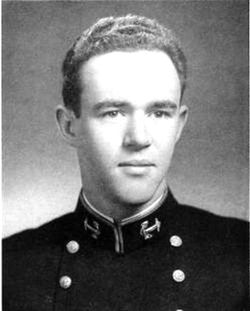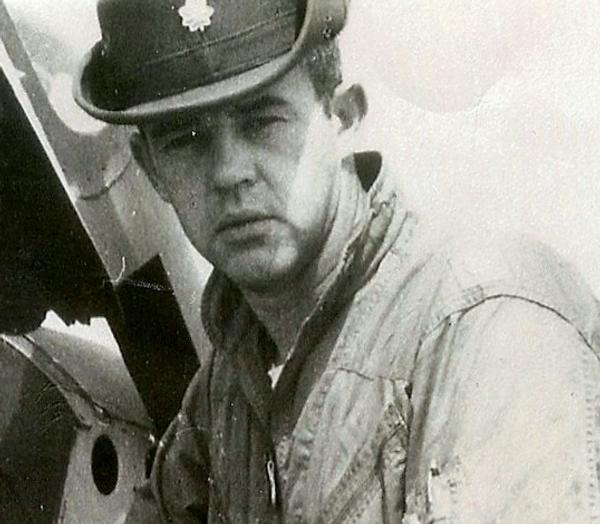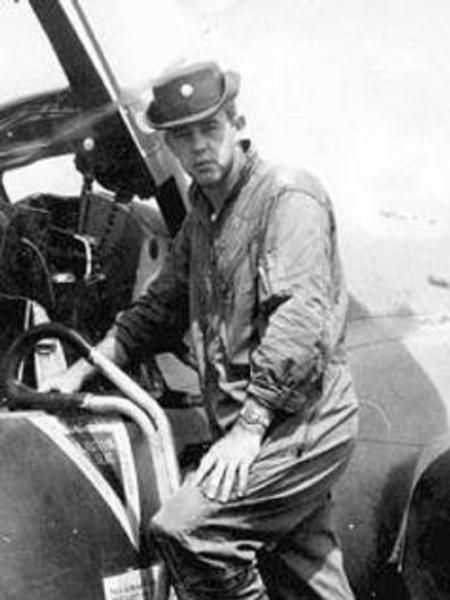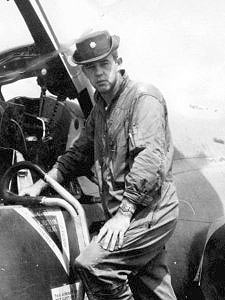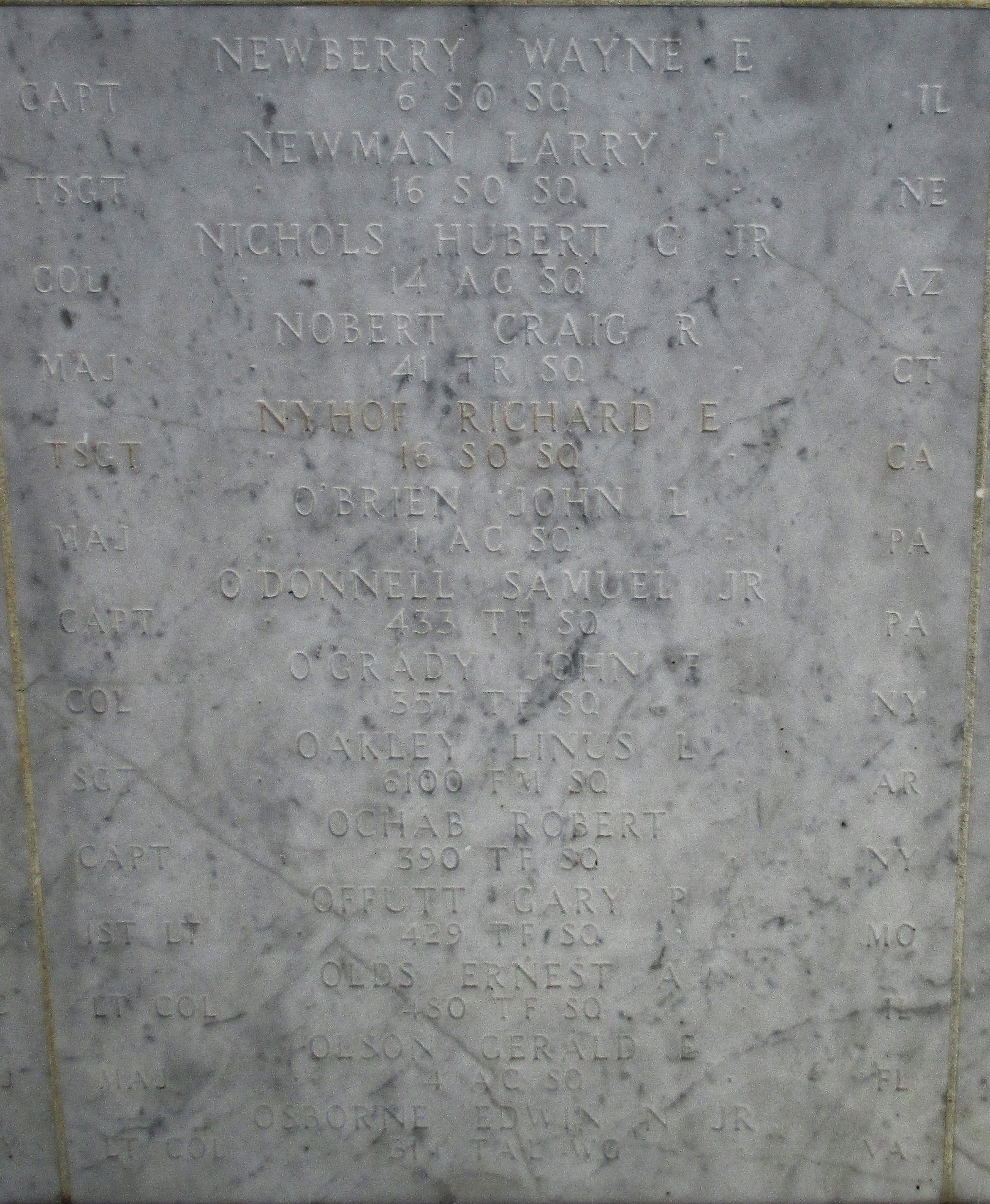Colonel, U.S. Air Force
357th Tactical Fighter Squadron
Entered the Service From: New Hyde Park, New York
Date of Birth: August 31, 1929
Date of Death: April 10, 1967
Wars or Conflicts: Vietnam War
Memorialized: Courts of the Missing: Court A
Honolulu Memorial
National Memorial Cemetery of the Pacific
Colonel O'Grady was a member of the 357th Tactical Fighter Squadron, Takhli Airfield, Thailand. On April 10, 1967, he was the pilot of a Thunderchief Fighter (F-105D) on an armed reconnaissance near Mu Gia Pass, North Vietnam. After releasing his bombs on target, his aircraft was hit by enemy fire and he ejected safely but could not be contacted. His remains were not recovered. His name is inscribed on the Courts of the Missing at the Honolulu Memorial
-----------NOTE:
Upon reaching his target, O'Grady began his bombing run without opposition with his wingman 20 seconds to his rear. Approaching the target, he did not like his alignment. Rather than "drop and run", he aborted his first run and rolled in behind his wingman for a second attack, and his third exposure to enemy gunners. This time, O'Grady's aircraft was hit and he radioed, "Losing
control, got to get out."
The wingman at first could not locate O'Grady's plane or parachute, but did witness his bombs land directly on target. Scanning the skies, the wingman finally saw O'Grady's parachute in the air southwest of the target. However, the wind was blowing O'Grady back to the area of the strike. According to the senior officer in the air, they could have rescued him except for the
wind.
O'Grady's parachute disappeared the instant it touched down. The exact spot was pinpointed but rescue planes found to trace of him when they searched the area minutes later while under intense ground fire. Later intelligence
indicated that O'Grady's target had been a well-organized, heavily armed battalion of enemy troops moving south through the Pass.
The next day, two radio broadcasts out of Hanoi and Peking detailed the capture of American pilots, identifying one of the provinces as the one where O'Grady went down. He was the only many shot down in that province that day, and the only pilot lost that week over all of North Vietnam.
Although the Air Force concluded that O'Grady was "in all probability taken captive", he was listed Missing in Action, and his status was never changed to Prisoner of War.
Colonel, U.S. Air Force
357th Tactical Fighter Squadron
Entered the Service From: New Hyde Park, New York
Date of Birth: August 31, 1929
Date of Death: April 10, 1967
Wars or Conflicts: Vietnam War
Memorialized: Courts of the Missing: Court A
Honolulu Memorial
National Memorial Cemetery of the Pacific
Colonel O'Grady was a member of the 357th Tactical Fighter Squadron, Takhli Airfield, Thailand. On April 10, 1967, he was the pilot of a Thunderchief Fighter (F-105D) on an armed reconnaissance near Mu Gia Pass, North Vietnam. After releasing his bombs on target, his aircraft was hit by enemy fire and he ejected safely but could not be contacted. His remains were not recovered. His name is inscribed on the Courts of the Missing at the Honolulu Memorial
-----------NOTE:
Upon reaching his target, O'Grady began his bombing run without opposition with his wingman 20 seconds to his rear. Approaching the target, he did not like his alignment. Rather than "drop and run", he aborted his first run and rolled in behind his wingman for a second attack, and his third exposure to enemy gunners. This time, O'Grady's aircraft was hit and he radioed, "Losing
control, got to get out."
The wingman at first could not locate O'Grady's plane or parachute, but did witness his bombs land directly on target. Scanning the skies, the wingman finally saw O'Grady's parachute in the air southwest of the target. However, the wind was blowing O'Grady back to the area of the strike. According to the senior officer in the air, they could have rescued him except for the
wind.
O'Grady's parachute disappeared the instant it touched down. The exact spot was pinpointed but rescue planes found to trace of him when they searched the area minutes later while under intense ground fire. Later intelligence
indicated that O'Grady's target had been a well-organized, heavily armed battalion of enemy troops moving south through the Pass.
The next day, two radio broadcasts out of Hanoi and Peking detailed the capture of American pilots, identifying one of the provinces as the one where O'Grady went down. He was the only many shot down in that province that day, and the only pilot lost that week over all of North Vietnam.
Although the Air Force concluded that O'Grady was "in all probability taken captive", he was listed Missing in Action, and his status was never changed to Prisoner of War.
